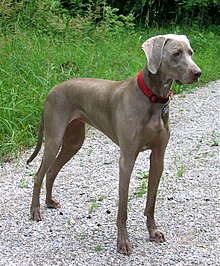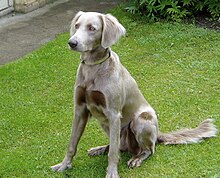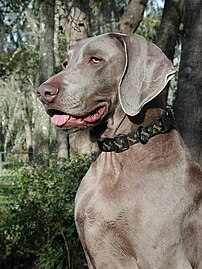Weimaraner: Difference between revisions
Traumnovelle (talk | contribs) Undid revision 1221439754 by Crunchydillpickle (talk) Word is still used and WP is not censored, changes lead to grammatically incorrect captions. |
Converted footnotes to LDR format (using segregate-refs); rm two (a puppy marketing sate and a random breeder's page) with associated content |
||
| Line 6: | Line 6: | ||
| image = Weimaraner Freika-2.jpg |
| image = Weimaraner Freika-2.jpg |
||
| image_caption = Short-haired bitch, two years old |
| image_caption = Short-haired bitch, two years old |
||
| maleweight = {{convert|30|-|40|kg|lb|abbr=on}}<ref name= |
| maleweight = {{convert|30|-|40|kg|lb|abbr=on}}<ref name=fci /> |
||
| femaleweight = {{convert|25|-|35|kg|lb|abbr=on}}<ref name= |
| femaleweight = {{convert|25|-|35|kg|lb|abbr=on}}<ref name=fci /> |
||
| maleheight = {{convert|59|-|70|cm|in|abbr=on}}<ref name= |
| maleheight = {{convert|59|-|70|cm|in|abbr=on}}<ref name=fci /> |
||
| femaleheight = {{convert|57|-|65|cm|in|abbr=on}}<ref name= |
| femaleheight = {{convert|57|-|65|cm|in|abbr=on}}<ref name=fci /> |
||
| life_span = 11–14 years<ref name=vj/> |
|||
| ⚫ | |||
| kc_name = [[Verband für das Deutsche Hundewesen]] |
| kc_name = [[Verband für das Deutsche Hundewesen]] |
||
| kc_std = https://www.vdh.de/welpen/mein-welpe/weimaraner |
| kc_std = https://www.vdh.de/welpen/mein-welpe/weimaraner |
||
| Line 16: | Line 16: | ||
}} |
}} |
||
The '''{{lang|de|italic=no|Weimaraner}}'''{{efn|name= a}} is a German [[list of dog breeds|breed]] of [[hunting dog]] of medium to large size, with history going back at least to the early nineteenth century.<ref |
The '''{{lang|de|italic=no|Weimaraner}}'''{{efn|name= a}} is a German [[list of dog breeds|breed]] of [[hunting dog]] of medium to large size, with history going back at least to the early nineteenth century.<ref name=kc/> Early Weimaraners were used by [[royal family|royalty]] for [[hunting]] large game such as [[boar]], [[bear]], and [[deer]]. As the popularity of hunting large game began to decline, Weimaraners were used for hunting smaller animals like [[fowl]], [[rabbit]]s, and [[fox]]es. |
||
The name comes from the Grand Duke of [[Saxe-Weimar-Eisenach]], [[Carl August of Saxe-Weimar-Eisenach|Karl August]], whose court, located in the city of [[Weimar]] (now in the state of [[Thuringia]] in modern-day [[Germany]]), enjoyed hunting. The Weimaraner is an all-purpose [[gun dog]], and possesses traits such as speed, stamina, great sense of smell, great eyes, courage, and intelligence.<ref name= |
The name comes from the Grand Duke of [[Saxe-Weimar-Eisenach]], [[Carl August of Saxe-Weimar-Eisenach|Karl August]], whose court, located in the city of [[Weimar]] (now in the state of [[Thuringia]] in modern-day [[Germany]]), enjoyed hunting. The Weimaraner is an all-purpose [[gun dog]], and possesses traits such as speed, stamina, great sense of smell, great eyes, courage, and intelligence.<ref name=gj/> The breed is sometimes referred to as the "grey ghost" of the dog world because of its ghostly coat and eye color along with its stealthy hunting style.<ref name=gj /> |
||
==History== |
==History== |
||
[[File:Leithund.png|thumb|A Leithund, possible ancestor to the Weimaraner<ref name= |
[[File:Leithund.png|thumb|A Leithund, possible ancestor to the Weimaraner<ref name=fci/>]] |
||
The Weimaraner was kept in the Weimar court in the 19th century and carried a good deal of Leithound ancestry.<ref name= |
The Weimaraner was kept in the Weimar court in the 19th century and carried a good deal of Leithound ancestry.<ref name=fci/> In the beginning, Germany's Grand Duke [[Karl August, Grand Duke of Saxe-Weimar-Eisenach|Karl August]] used the Weimaraner to hunt big game like wolves, bears, and boar, but as Europe's number of big game animals decreased, the Weimaraner turned into a point-and-retrieve hunter of small game.<ref name=akc/> The breed arrived to America in the late 1920s, and its popularity increased in the 1950s,<ref name=akc /> largely because of celebrities like [[Grace Kelly]], President [[Dwight D. Eisenhower]], and [[Dick Clark]]. The famous artist and photographer [[William Wegman (photographer)|William Wegman]] increased the breed's popularity even more with his world-famous Weimaraner portraits and video segments. |
||
==Description== |
==Description== |
||
| Line 30: | Line 30: | ||
The eyes of the Weimaraner may be light amber, grey, or blue-grey, and the ears are long and velvety.{{cn|date=April 2024}} |
The eyes of the Weimaraner may be light amber, grey, or blue-grey, and the ears are long and velvety.{{cn|date=April 2024}} |
||
In November 2009 and on 1 January 2010, the [[United Kennel Club]] (UKC) removed the disqualification from Blue and Longhair Weimaraners. A black coat remains an automatic disqualification, though a small white marking in the chest area only is permitted. Dogs with blue coats are disqualified from conformation/show competition,<ref |
In November 2009 and on 1 January 2010, the [[United Kennel Club]] (UKC) removed the disqualification from Blue and Longhair Weimaraners. A black coat remains an automatic disqualification, though a small white marking in the chest area only is permitted. Dogs with blue coats are disqualified from conformation/show competition,<ref name=akc2/> but are recognized as purebred Weimaraners by the AKC. |
||
A long-haired variety is recognized by most kennel clubs around the world except the American Kennel Club. The long-haired Weimaraner has a silky coat with an undocked, feathered tail.{{cn|date=April 2024}} |
A long-haired variety is recognized by most kennel clubs around the world except the American Kennel Club. The long-haired Weimaraner has a silky coat with an undocked, feathered tail.{{cn|date=April 2024}} |
||
According to the [[Fédération Cynologique Internationale]] standard, the male Weimaraner stands {{convert|59|to|70|cm|in|abbr=on}} at the [[withers]]. Females are {{convert|57|to|65|cm|in|abbr=on}}. Males normally weigh about {{convert|30|-|40|kg|lb|abbr=on}}. Females are generally {{convert|25|-|35|kg|lb|abbr=on}}.<ref name= |
According to the [[Fédération Cynologique Internationale]] standard, the male Weimaraner stands {{convert|59|to|70|cm|in|abbr=on}} at the [[withers]]. Females are {{convert|57|to|65|cm|in|abbr=on}}. Males normally weigh about {{convert|30|-|40|kg|lb|abbr=on}}. Females are generally {{convert|25|-|35|kg|lb|abbr=on}}.<ref name=fci/> A Weimaraner should give the appearance of a muscular, athletic dog. |
||
<gallery mode=packed heights=180px style="text-align:left; font-size:94%"> |
<gallery mode=packed heights=180px style="text-align:left; font-size:94%"> |
||
File:Langhaarweimaraner Staßfurt.jpg|A long-haired bitch |
File:Langhaarweimaraner Staßfurt.jpg|A long-haired bitch |
||
| Line 42: | Line 42: | ||
</gallery> |
</gallery> |
||
==Health== |
==Health== |
||
According to the Orthopedic Foundation for Animals, Weimaraners enjoy low rates of [[Hip dysplasia (canine)|dysplasia]]. The breed is ranked 102nd of 153 total breeds and has a very high test rate and a very high percentage of excellent rating among those dogs tested.<ref |
According to the Orthopedic Foundation for Animals, Weimaraners enjoy low rates of [[Hip dysplasia (canine)|dysplasia]]. The breed is ranked 102nd of 153 total breeds and has a very high test rate and a very high percentage of excellent rating among those dogs tested.<ref name=offa/> |
||
Other health issues include: |
Other health issues include: |
||
* [[Cryptorchidism]]<ref name=wca/> |
|||
| ⚫ | |||
* [[Distichiasis]]<ref name= |
* [[Distichiasis]]<ref name=wca/> |
||
* [[Elbow dysplasia]]<ref name=vs/> |
|||
| ⚫ | |||
* [[Entropion]]<ref name=cidd/> |
|||
| ⚫ | |||
* [[Growth hormone deficiency|Pituitary dwarfism]]<ref name= |
* [[Growth hormone deficiency|Pituitary dwarfism]]<ref name=wca/><ref name=cidd/> |
||
* [[Hypertrophic osteodystrophy]]<ref name= |
* [[Hypertrophic osteodystrophy]]<ref name=cidd/> |
||
* [[Hypomyelination-congenital cataract syndrome|Hypomyelinogenesis]]<ref name= |
* [[Hypomyelination-congenital cataract syndrome|Hypomyelinogenesis]]<ref name=cidd/> |
||
* [[Hypothyroidism]]<ref name= |
* [[Hypothyroidism]]<ref name=wca/> |
||
* [[Progressive retinal atrophy]] |
* [[Progressive retinal atrophy]] |
||
* [[Renal dysplasia]]<ref name= |
* [[Renal dysplasia]]<ref name=cidd/> |
||
* [[Von Willebrands Disease]]<ref name= |
* [[Von Willebrands Disease]]<ref name=wca/> |
||
== Notes == |
== Notes == |
||
| Line 64: | Line 64: | ||
== References == |
== References == |
||
| ⚫ | |||
==External links== |
|||
{{commonscat}} |
{{commonscat}} |
||
| ⚫ | |||
* [http://www.weimaranerpedigrees.com The Weimaraner Pedigree database] |
|||
<ref name=akc>{{Cite web|title=Weimaraner Dog Breed Information|url=https://www.akc.org/dog-breeds/weimaraner/|access-date=26 April 2021|website=American Kennel Club|language=en}}</ref> |
|||
<ref name=akc2>[http://www.akc.org/breeds/weimaraner/ Weimaraner Page<!-- Bot generated title -->]</ref> |
|||
| ⚫ | <ref name=cidd>{{cite web|url=http://www.upei.ca/~cidd/breeds/weimaraner2.htm |publisher=Canine Inherited Disorders Database |title=Weimaraners |url-status=dead |archive-url=https://web.archive.org/web/20070219233203/http://www.upei.ca/~cidd/breeds/weimaraner2.htm |archive-date=19 February 2007 }}</ref> |
||
<ref name=fci>{{cite web |title=Weimaraner standard |url=http://www.fci.be/Nomenclature/Standards/099g07-en.pdf |publisher=FCI |access-date=25 April 2017}}</ref> |
|||
<ref name=gj>{{Cite web|title=Weimaraner {{!}} Gundog breeds {{!}} Gundog Journal|url=https://gundog-journal.com/article/weimaraner|access-date=26 April 2021|website=gundog-journal.com}}</ref> |
|||
<ref name=kc>{{cite web|title=Weimaraner|url=http://www.thekennelclub.org.uk/services/public/breed/display.aspx?id=2058|publisher=The Kennel Club|access-date=26 December 2016}}</ref> |
|||
<ref name="AutoAC-3">{{cite web|last1=Deep|first1=John|title=Weimaraner|url=http://2puppies.com/dog-breed/weimaraner/|website=2puppies|access-date=26 December 2016}}</ref> |
|||
<ref name="AutoAC-4">{{Cite web|url=https://www.royalsplendour.cz/weimaraner/breed-history/|title=Weimaraner Breed History|last=Kočov|first=Dr. Jana|website=Royal Splendour}}</ref> |
|||
<ref name=offa>{{cite web |publisher=OFFA |url=http://www.caninehealthinfo.org/brdreqs.html?breed=WE |title= Weimaraner }}</ref> |
|||
| ⚫ | <ref name=vs>{{cite journal|last1=FITZPATRICK|first1=NOEL|last2=SMITH|first2=THOMAS J.|last3=EVANS|first3=RICHARD B.|last4=YEADON|first4=RUSSELL|title=Radiographic and Arthroscopic Findings in the Elbow Joints of 263 Dogs with Medial Coronoid Disease|journal=Veterinary Surgery|date=February 2009|volume=38|issue=2|pages=213–223|doi=10.1111/j.1532-950X.2008.00489.x|pmid=19236680|doi-access=free}}</ref> |
||
| ⚫ | <ref name=vj>{{Cite journal | last1 = O’Neill | first1 = D. G. | last2 = Church | first2 = D. B. | last3 = McGreevy | first3 = P. D. | last4 = Thomson | first4 = P. C. | last5 = Brodbelt | first5 = D. C. | title = Longevity and mortality of owned dogs in England | doi = 10.1016/j.tvjl.2013.09.020 | journal = The Veterinary Journal | year = 2013 | pmid = 24206631| volume=198 | issue = 3 | pages=638–43| url = https://researchonline.rvc.ac.uk/id/eprint/7826/1/7826.pdf }} "n=26, median=12.6, [[IQR]]=11.1–13.5"</ref> |
||
| ⚫ | |||
}} |
|||
{{Gundogs}} |
{{Gundogs}} |
||
Revision as of 16:53, 30 April 2024
| Weimaraner | |||||||||||||||||||||
|---|---|---|---|---|---|---|---|---|---|---|---|---|---|---|---|---|---|---|---|---|---|
 Short-haired bitch, two years old | |||||||||||||||||||||
| Origin | Germany | ||||||||||||||||||||
| |||||||||||||||||||||
| |||||||||||||||||||||
| Dog (domestic dog) | |||||||||||||||||||||
The Weimaraner[a] is a German breed of hunting dog of medium to large size, with history going back at least to the early nineteenth century.[3] Early Weimaraners were used by royalty for hunting large game such as boar, bear, and deer. As the popularity of hunting large game began to decline, Weimaraners were used for hunting smaller animals like fowl, rabbits, and foxes.
The name comes from the Grand Duke of Saxe-Weimar-Eisenach, Karl August, whose court, located in the city of Weimar (now in the state of Thuringia in modern-day Germany), enjoyed hunting. The Weimaraner is an all-purpose gun dog, and possesses traits such as speed, stamina, great sense of smell, great eyes, courage, and intelligence.[4] The breed is sometimes referred to as the "grey ghost" of the dog world because of its ghostly coat and eye color along with its stealthy hunting style.[4]
History

The Weimaraner was kept in the Weimar court in the 19th century and carried a good deal of Leithound ancestry.[1] In the beginning, Germany's Grand Duke Karl August used the Weimaraner to hunt big game like wolves, bears, and boar, but as Europe's number of big game animals decreased, the Weimaraner turned into a point-and-retrieve hunter of small game.[5] The breed arrived to America in the late 1920s, and its popularity increased in the 1950s,[5] largely because of celebrities like Grace Kelly, President Dwight D. Eisenhower, and Dick Clark. The famous artist and photographer William Wegman increased the breed's popularity even more with his world-famous Weimaraner portraits and video segments.
Description

The eyes of the Weimaraner may be light amber, grey, or blue-grey, and the ears are long and velvety.[citation needed]
In November 2009 and on 1 January 2010, the United Kennel Club (UKC) removed the disqualification from Blue and Longhair Weimaraners. A black coat remains an automatic disqualification, though a small white marking in the chest area only is permitted. Dogs with blue coats are disqualified from conformation/show competition,[6] but are recognized as purebred Weimaraners by the AKC.
A long-haired variety is recognized by most kennel clubs around the world except the American Kennel Club. The long-haired Weimaraner has a silky coat with an undocked, feathered tail.[citation needed]
According to the Fédération Cynologique Internationale standard, the male Weimaraner stands 59 to 70 cm (23 to 28 in) at the withers. Females are 57 to 65 cm (22 to 26 in). Males normally weigh about 30–40 kg (66–88 lb). Females are generally 25–35 kg (55–77 lb).[1] A Weimaraner should give the appearance of a muscular, athletic dog.
-
A long-haired bitch
-
Blue is not an accepted colour
Health
According to the Orthopedic Foundation for Animals, Weimaraners enjoy low rates of dysplasia. The breed is ranked 102nd of 153 total breeds and has a very high test rate and a very high percentage of excellent rating among those dogs tested.[7]
Other health issues include:
- Cryptorchidism[8]
- Distichiasis[8]
- Elbow dysplasia[9]
- Entropion[10]
- Pituitary dwarfism[8][10]
- Hypertrophic osteodystrophy[10]
- Hypomyelinogenesis[10]
- Hypothyroidism[8]
- Progressive retinal atrophy
- Renal dysplasia[10]
- Von Willebrands Disease[8]
Notes
References
- ^ a b c d e f g "Weimaraner standard" (PDF). FCI. Retrieved 25 April 2017.
- ^ O’Neill, D. G.; Church, D. B.; McGreevy, P. D.; Thomson, P. C.; Brodbelt, D. C. (2013). "Longevity and mortality of owned dogs in England" (PDF). The Veterinary Journal. 198 (3): 638–43. doi:10.1016/j.tvjl.2013.09.020. PMID 24206631. "n=26, median=12.6, IQR=11.1–13.5"
- ^ "Weimaraner". The Kennel Club. Retrieved 26 December 2016.
- ^ a b "Weimaraner | Gundog breeds | Gundog Journal". gundog-journal.com. Retrieved 26 April 2021.
- ^ a b "Weimaraner Dog Breed Information". American Kennel Club. Retrieved 26 April 2021.
- ^ Weimaraner Page
- ^ "Weimaraner". OFFA.
- ^ a b c d e "List of common problems afflicting Weimaraners". Weimaraner Club of America.
- ^ FITZPATRICK, NOEL; SMITH, THOMAS J.; EVANS, RICHARD B.; YEADON, RUSSELL (February 2009). "Radiographic and Arthroscopic Findings in the Elbow Joints of 263 Dogs with Medial Coronoid Disease". Veterinary Surgery. 38 (2): 213–223. doi:10.1111/j.1532-950X.2008.00489.x. PMID 19236680.
- ^ a b c d e "Weimaraners". Canine Inherited Disorders Database. Archived from the original on 19 February 2007.
Cite error: A list-defined reference named "AutoAC-3" is not used in the content (see the help page).




